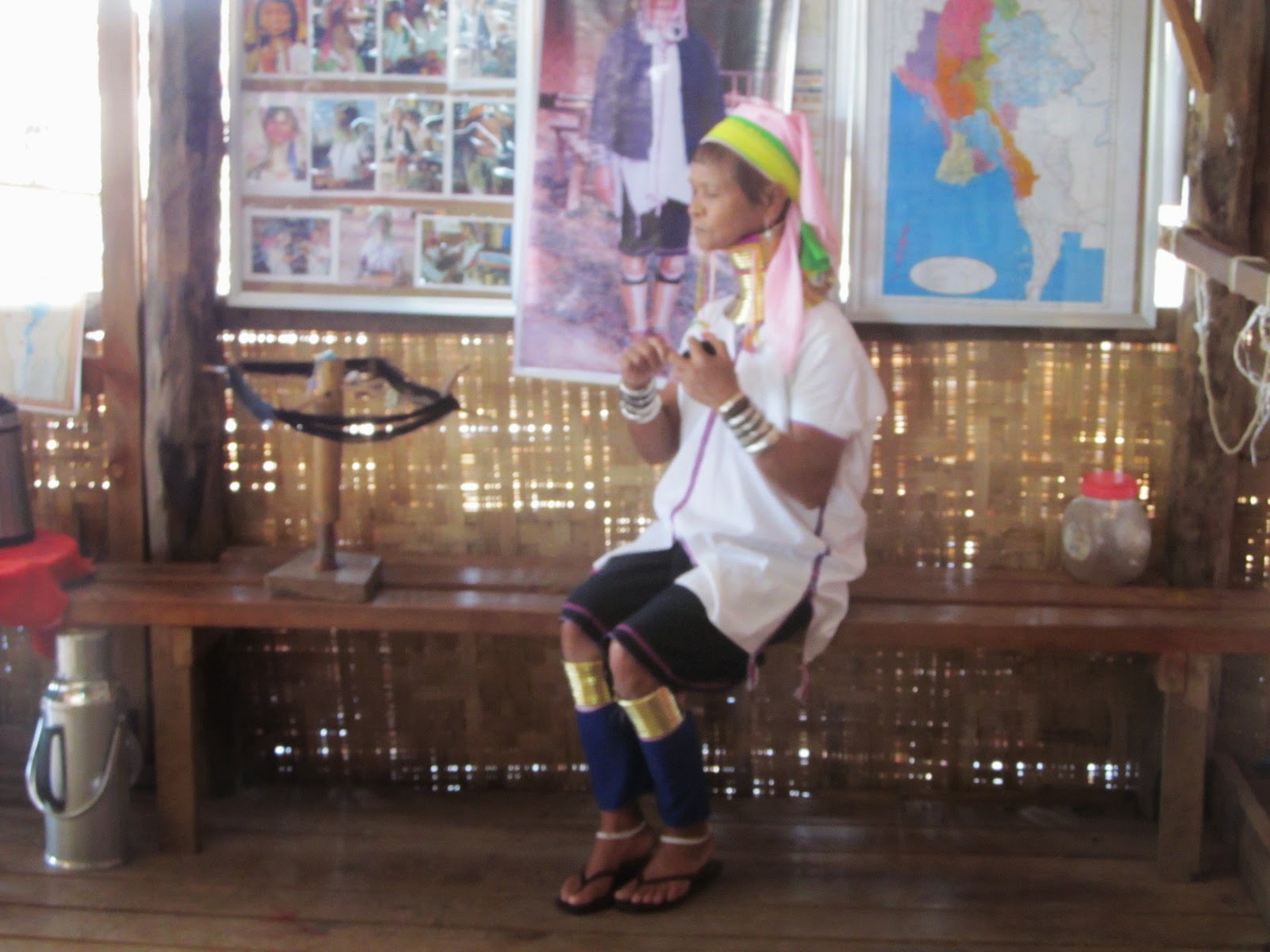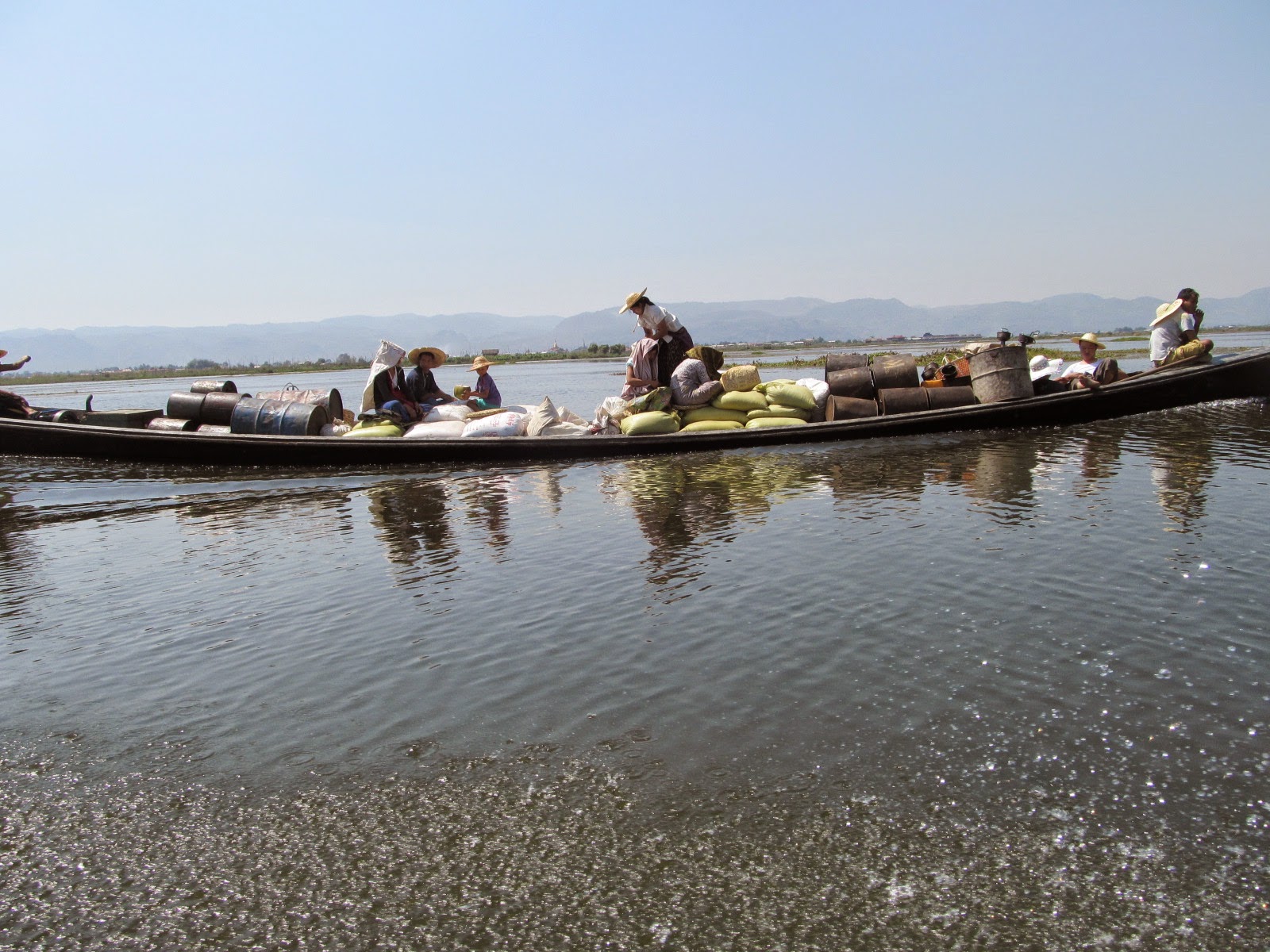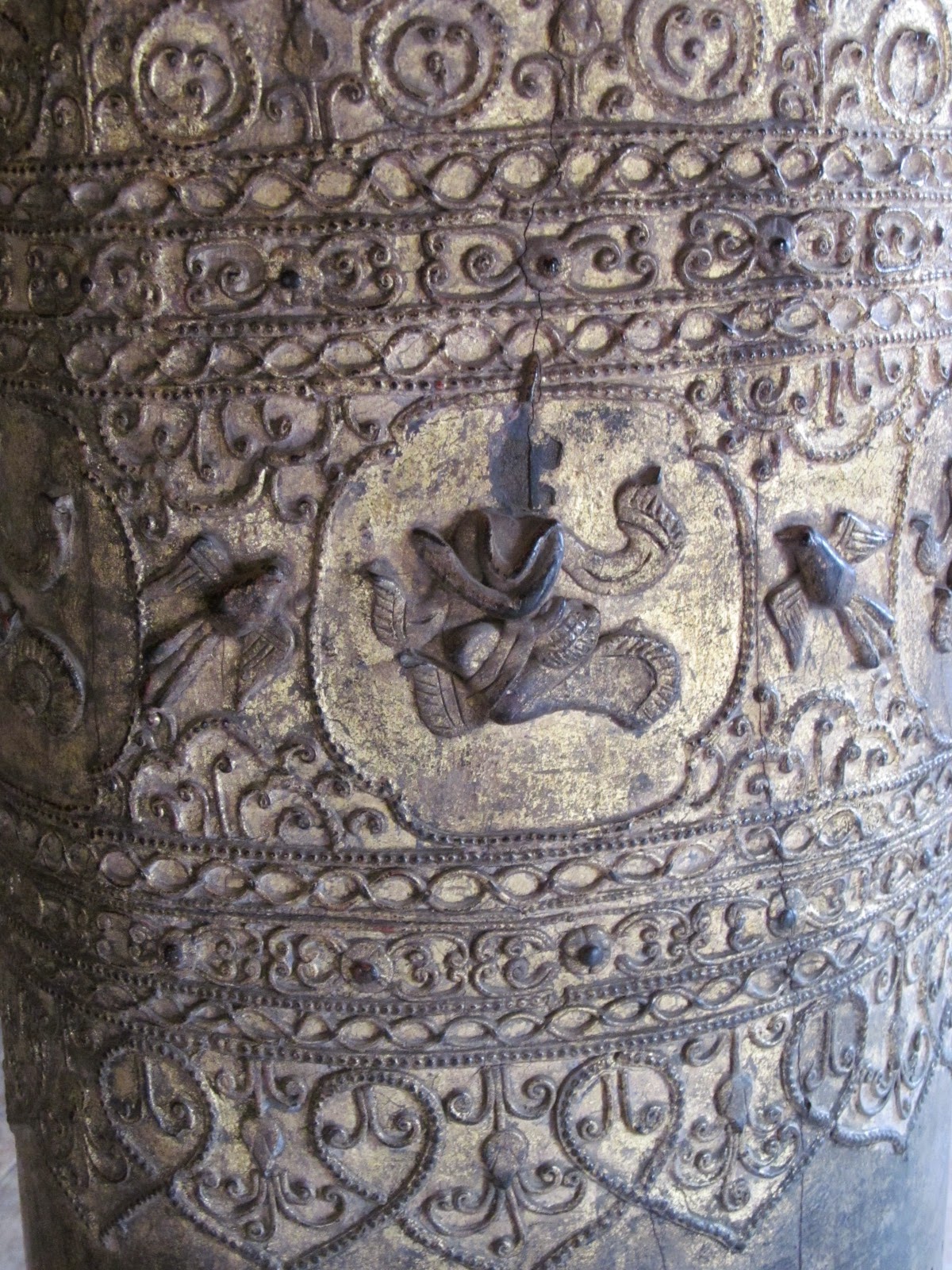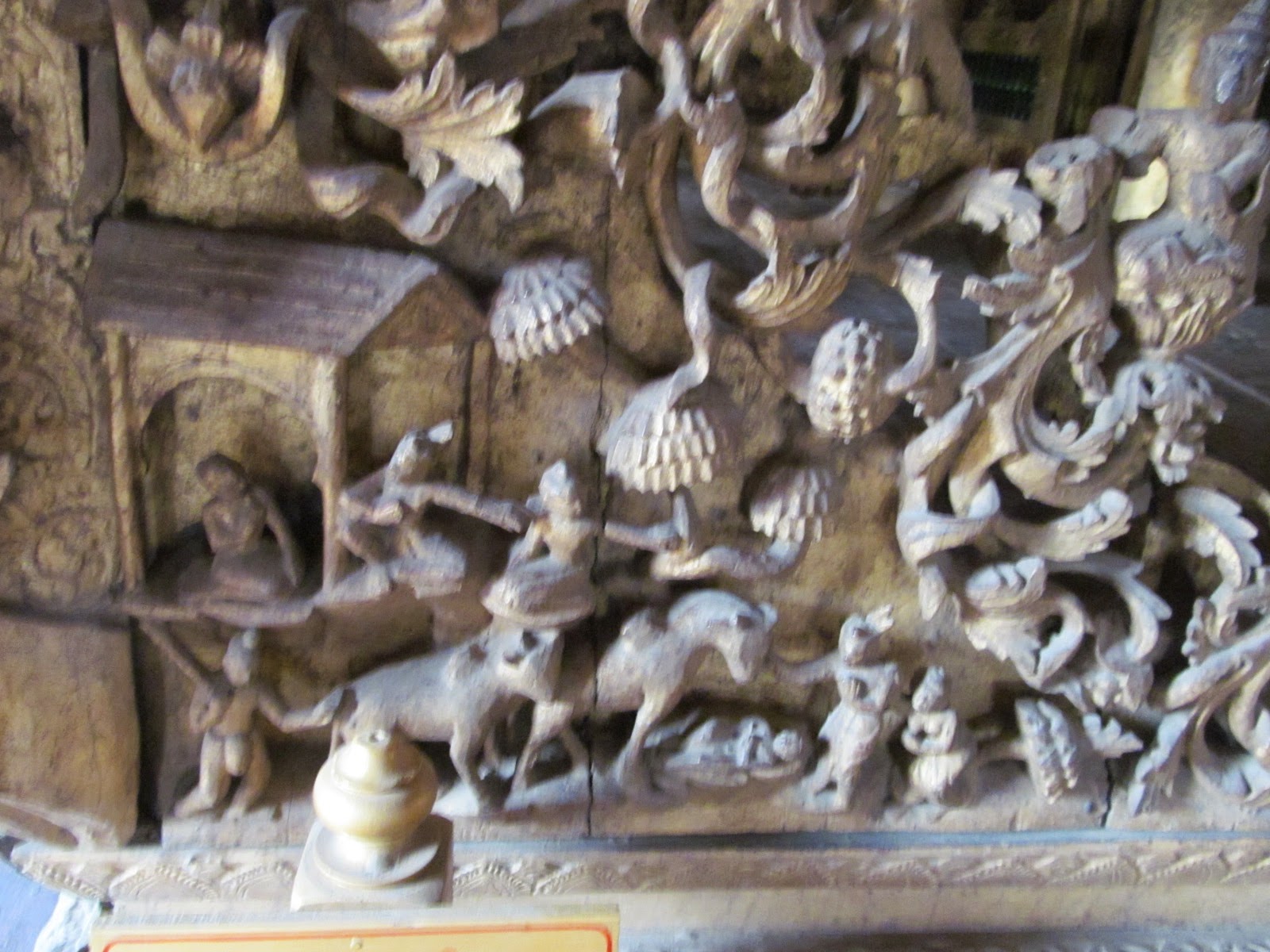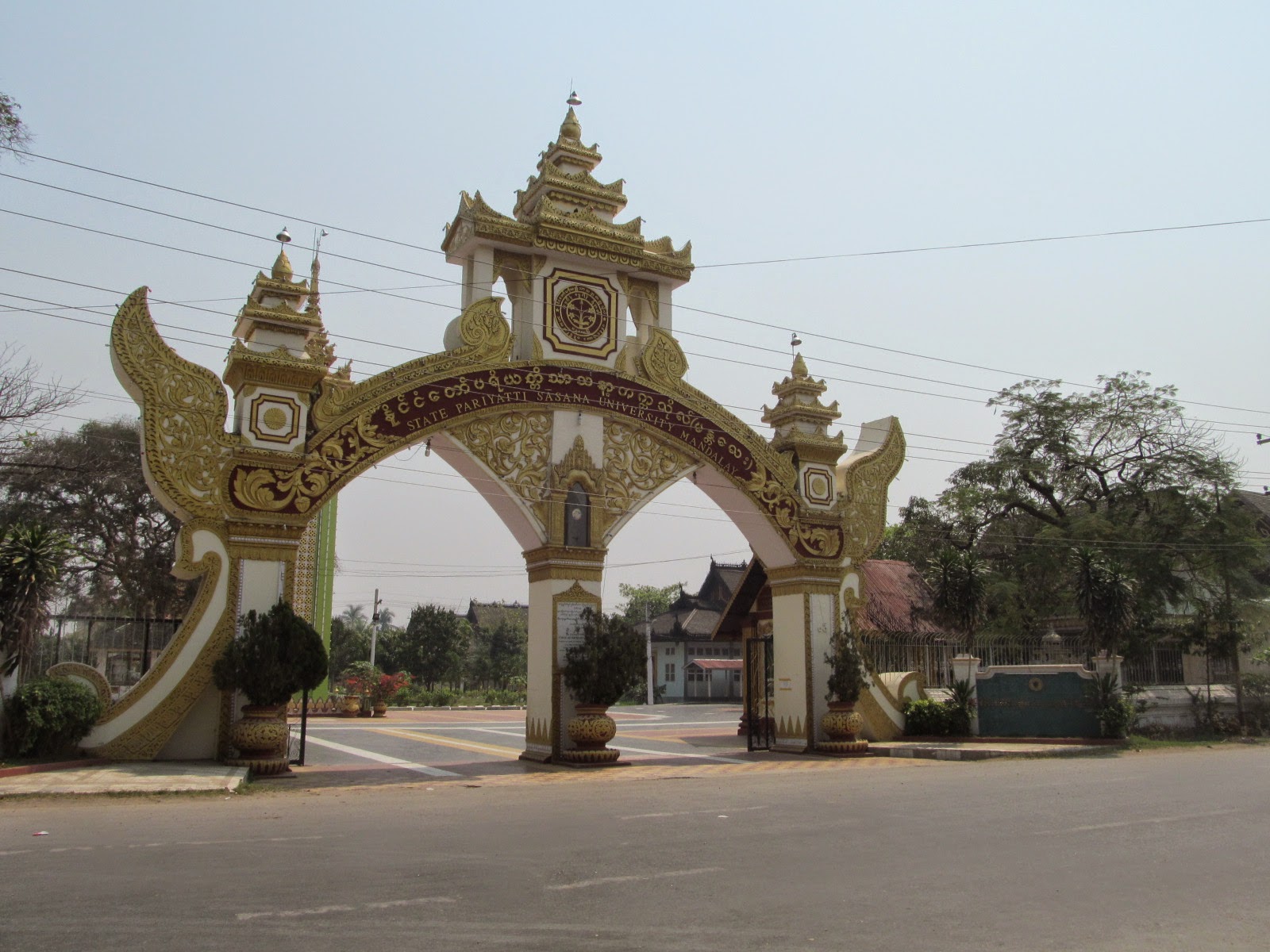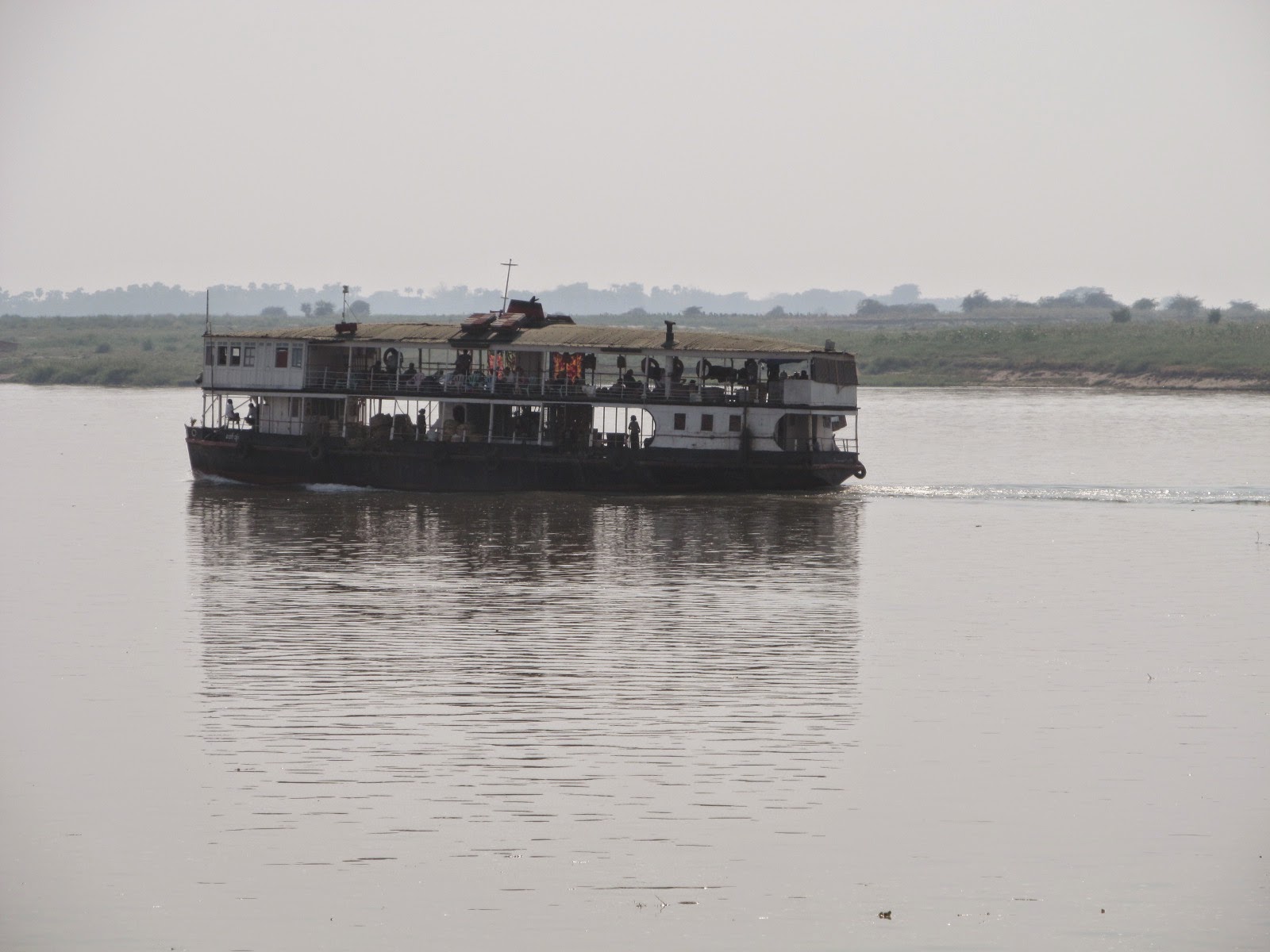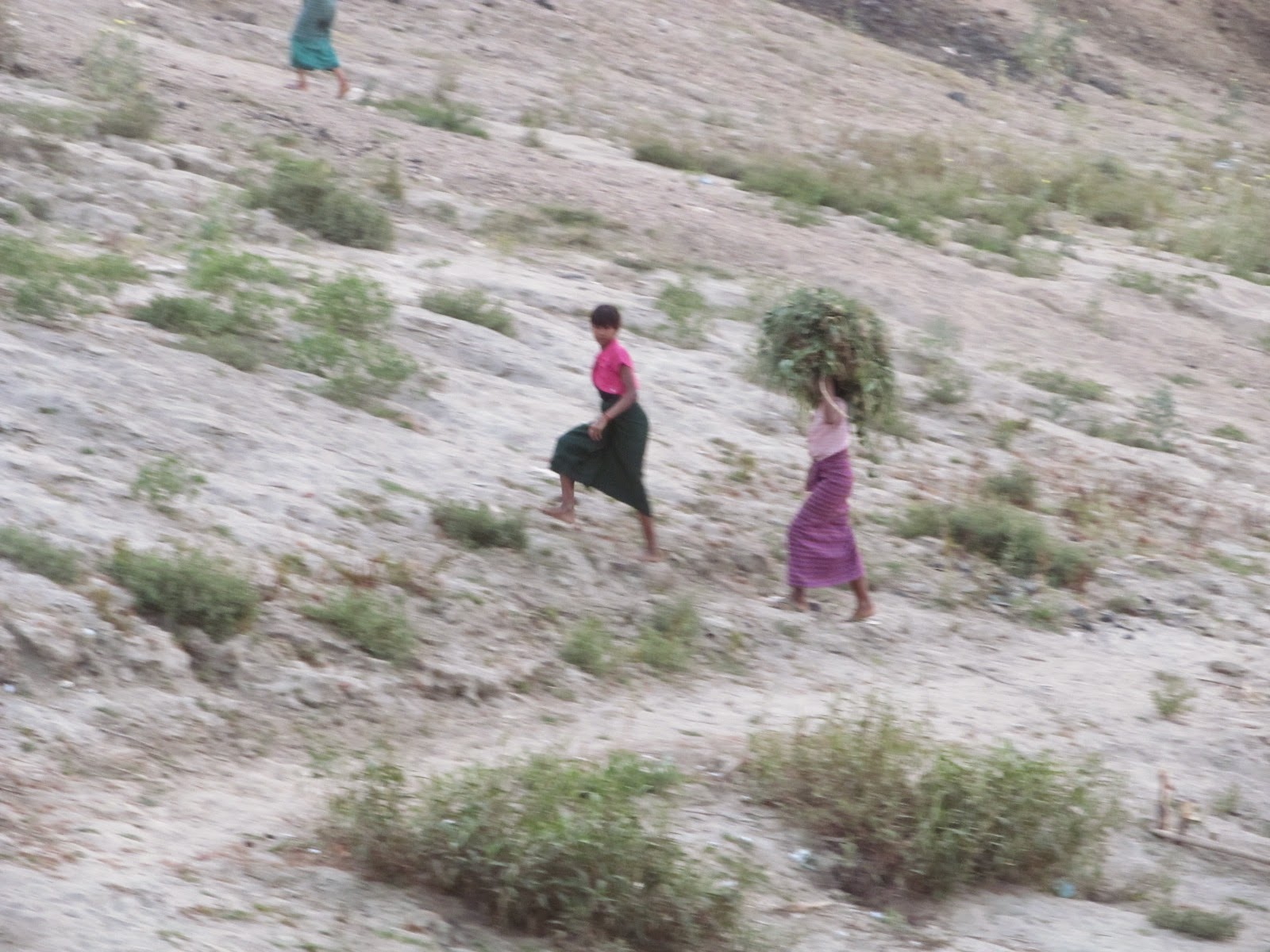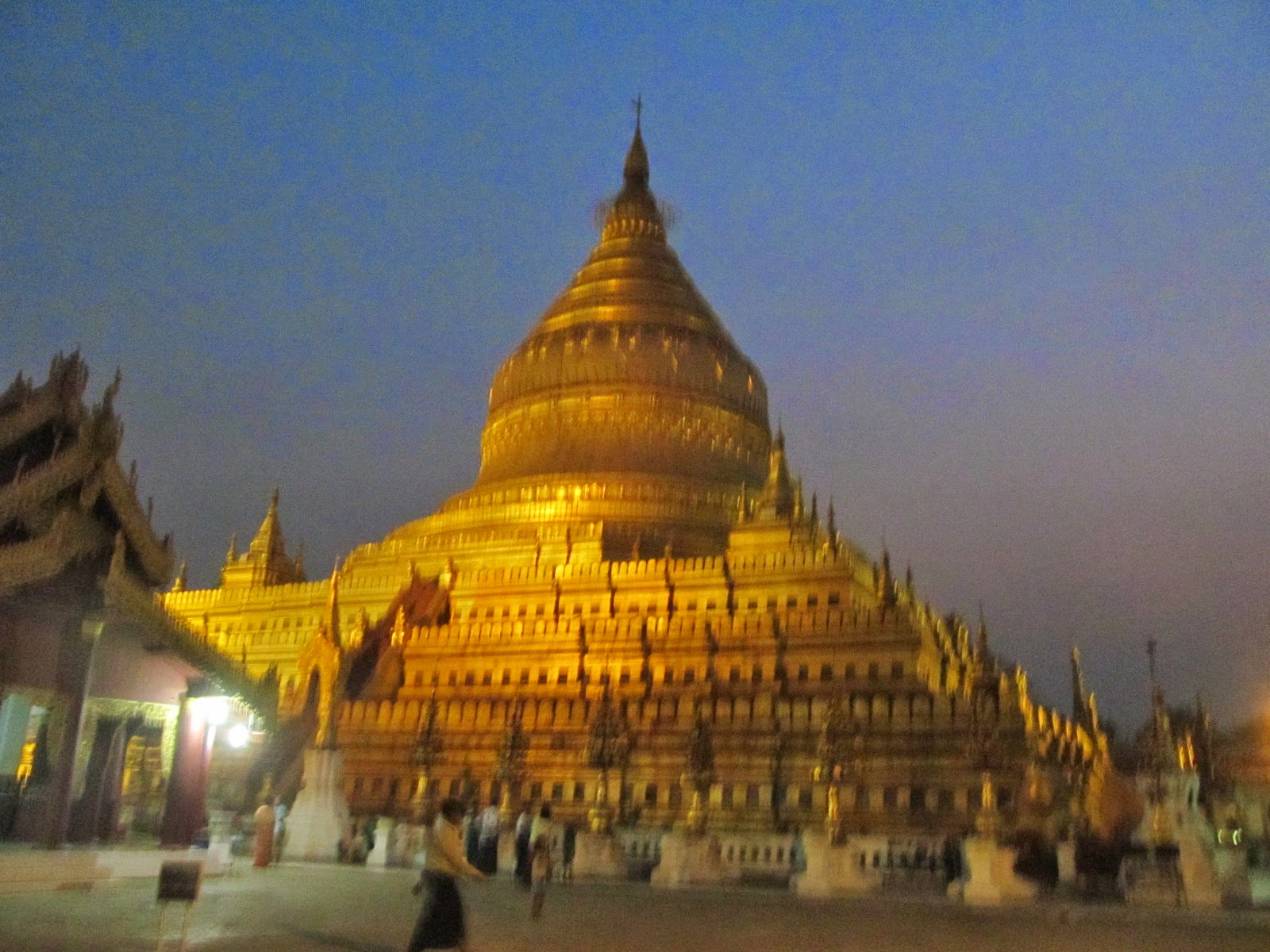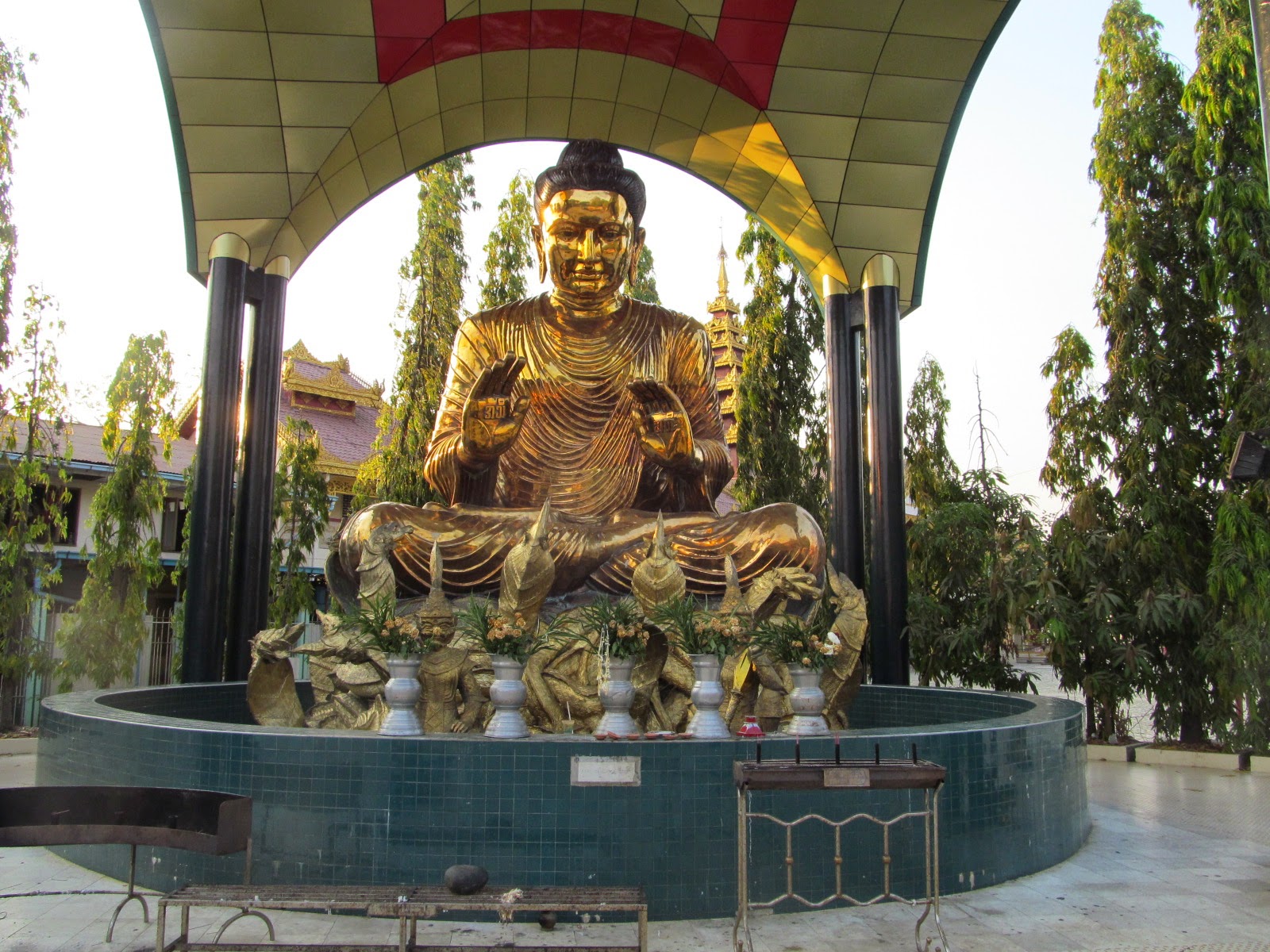Hong Kong, Myanmar
& Thailand
23 February - 19 March
2015
The best laid
schemes....Gang aft agley.
---Robert Burns
When we planned the trip, we intended to fly from DFW to LAX on
Monday morning, rent a day room and take the "midnight flight" to
Hong Kong. Then the weather forecast changed and included a chance of freezing
precipitation on Monday morning. On Thursday morning we changed the tickets
from Monday morning to Sunday afternoon.
Sunday 22 February -
Tuesday 24 February – We flew from DFW to LAX. Before landing, we learned from a
flight attendant that it was to have been a turn-around-flight for them but the
LAX to DFW leg had been canceled because of ice. After claiming the bags, we
rode the shuttle to the Renaissance Los Angeles Airport Hotel. We just hung out
in the hotel on Monday. After checking out at 7:00p.m., we rode the shuttle bus
back to the airport where we checked in for our Cathay Pacific flight departing for Hong Kong at 12:05a.m. Tuesday.
Tuesday 24 February & Wednesday 25 February - Each
business class seat is a triangular-shaped cubicle with a flip out monitor and
a seat that lies flat. We landed in Hong Kong at 8:20a.m. Wednesday. We met a
representative from the “Four Seasons Hotel” who assisted us thorough Customs and
Immigration. Once outside the terminal, the car and driver were waiting and we
were soon on our way; the drive to the hotel takes about 40 minutes. Our room
has a harbor view but the fog really limits visibility. Because we had
complimentary access to the Executive Club Lounge, we ate all our hotel meals
there. Later that day we walked through the adjacent “IPC Mall”
and then through various streets on the island.




Thursday 26 February - We rode the “Star Ferry”
across the harbor to Kowloon. Once there we walked quite a way up Nathan Road
and then over a couple of blocks to a building housing the "Jade
Market" where we walked the aisles. Then we walked back
toward the terminal. Some of our rambling took us into back streets where
little seems to have changed; urban renewal hasn't hit all areas yet. Men on
the street offered to take us to "Custom Tailor;" we also fended off
many men touting "watches, bags and purses"---all of them "Good
Copy." Some of the stores---Prada & Burberry specifically---had lines
of Chinese waiting to enter; evidently there's a capacity rule. It seems odd
that the mainland Chinese want the real thing and Western tourists want the
copy. Then we the ferry back across the harbor and returned to the hotel. Later
we rode the ferry back across the harbor for the laser light showwhich began at
8:00. Hong Kong is still in the Chinese New Year Celebration.










Friday 27 February & Saturday 28 February –
We spent the days wandering both Hong Kong and Kowloon islands.





Sunday 1 March - We left the room about 10:15 to wander
the city. The first part took us through an area where all the foreign---Indonesian,
Malaysian, Filipina, etc.---maids congregate on their day off. We decided later
there were probably around a thousand and most appeared to be between fifteen
and twenty-five. Many were lined up at exchanges which wired money to other
countries; some had packages to send. Some areas of the elevated walkways had
clusters of young women seated along the edges. They were playing cards and
other games and visiting. Some of their areas were defined by blankets or other
fabric spread on the floor while others used flattened cardboard boxes. Some of
the cardboard areas had the sides turned up in sort of a "playhouse"
effect. After leaving that ultra-congested area, we got on the escalator and
rode up to Hollywood Road. While a number of shops were open, many would remain
closed until the Chinese New Year Celebration ends on 17 March. We window
shopped our way along the street to "Man Mo Temple." Outside the
temple, lines of people more than a block long stretched in both directions as
they waited for entrance; Chinese New Year is special. From there we walked
down Ladder Street and stopped on Circular Pathway, a cross street, which had a
market selling Chinese items. We continued down Ladder Street to Bonham Strand
East and walked along it until we reached Millennium Plaza which had seating, a
fountain and a New Year's Decoration.




After a brief rest, we wandered on
through the area with shops selling spices, ginseng and birds' nests before
walking back to the hotel.
Monday 2 March – We flew from Hong Kong to Bangkok..
[Because we had been to Bangkok at least twice before, we decided not to worry
with the traffic and stay at a hotel near the airport.] Once outside, someone
told us to go to Door 4 for the hotel. At that door was a kiosk; the person
there escorted us outside where a van was waiting to shuttle us to the
"Novotel Suvarnabhumi Hotel."
What a pleasant surprise! The hotel was very nice and we had free WiFi
as well as access to the "Business Club Lounge" for breakfast and
"cocktails."
"If you've 'eard
the East a-callin', you won't never 'eed naught else."
No! you won't 'eed
nothin' else,
But them spicy garlic
smells,
An' the sunshine an'
the palm-trees an' the tinkly temple-bells;
On the road to
Mandalay...
---Rudyard
Kipling
The main reason for the trip was to visit Myanmar. Our previous
visit in 2010 was simply to a border town in the "Golden Triangle"
area when we walked across the river from Thailand. We really wanted to see the
various stupas and temples for which the country is famous. We booked the tour
with A&K as a Tailor Made Journey which dovetailed with one of their
small group tours. Its appeal was time on a riverboat on the Irrawaddy River.
Since we were unsure of the infrastructure, we thought the riverboat a good
choice. We had a private guide and private car and driver for our tour. While
we would have preferred an earlier date, we were informed that this was the
first available sailing as all previous ones were fully booked. That being
said, our A&K arrangements were as promised and we couldn't have had a
better guide. Should we return to Myanmar, it should be in the rainy/cool
season instead of the hot/dry one. It was like August in Texas.
Tuesday 3 March - Bangkok to Yangon –
After checking out of the hotel, we rode the shuttle back to the airport and
found the check-in counter for our Thai Airlines flight. There was a special
security screening for Business Class passengers. After Immigration, we went to
a lounge and waited. The flight was late boarding. Finally we were checked in,
boarded a bus, given a tour of the hinterlands of the airport, and taken to a
plane. The flight took just over an hour but Yangon is a half hour behind
Bangkok, so we landed about on time. Once off the plane via jet bridge, we made
our way into the terminal. The very long "Visa on Arrival" line and
twisted several times, but we already had visas and went directly to
Immigration. We did have to wait several minutes for the bags to arrive.
Exiting the Baggage Claim Area, we met Nwe Si Win [aka SiSi], our A&K
guide, who took us to a waiting car. It was 99 degrees. She explained that the
name Burma was given to the country by the British when they colonized it and
that Myanmar had been the official name since independence from Britain in 1948;
also, the city has always been Yangon but the British mispronounced and
misspelled it Rangoon. SiSi pointed out various sites, many of which are now
known by their original names instead of their British-given ones, on the
almost-hour-long-drive to the "Sule Shangri La Hotel. Our room had access
to the "Horizon Lounge" on the 21st floor where we can have cocktails
and breakfast. While in the lounge, we made some photos of golden pagodas
through the windows.



As darkness fell, one contrast between Yangon and Hong
Kong became apparent: every building, street and surface in Hong Kong is ablaze
with light but Yangon has very little lighting and the city appears dark.
Wednesday 4 March - Yangon - At 7:30, we met SiSi and
headed for Shwedagone [Reliquary of the
Four] Pagoda, the most sacred Buddhist site in Myanmar because it houses
the relics (hair) of four Buddhas. Tradition holds that it has stood for 2,800
years---making it the oldest historical pagoda in the world. Because today is a
Buddhist Full Moon Day, crowds flocked there. We went early while it was
cooler. Our car dropped us near the entrance and we left our shoes and socks
inside. Then we rode an elevator to the complex; many locals prefer to climb
one of the stairways located at the cardinal points. We spent quite a while
wandering the fourteen-acre terrace while SiSi pointed out various important
areas to us. The intricate carvings and the ornate structures amazed us. Many
brought offerings; some families brought lunch. We learned that some would
spend the entire day inside the complex. Part of the
three-hundred-twenty-six-feet-tall stupa, which houses the hair relic of the
Buddha, was undergoing re-gilding, a process which happens every five years.
The opulence of the structure extends to parts inaccessible to tourists. At the
pinnacle is the 22-inch high Diamond Orb containing 4351 diamonds totaling
1,800 carats in its 10 1/2 inch diameter; crowning it is the 76 carat Apex Diamond.
Below that is The Vane composed of 924 pounds of gold; it is 4 feet, 2
inches long and 2 feet, 6 inches wide. Supporting both these is The
Umbrella, which is 43 feet height and 15 1/2 feet wide. Composed of
one-half-ton of gold; 83,850 jewels; and 4016 small gold bells, it weighs 5
tons. After spending quite a while inside the area admiring the various
pagodas and images of the Buddha (one in jade), we left the building.




























Our next
stop about three and a half miles away was to see the Reclining Buddha at
Chauk Htat Gyi Pagoda, a 213-foot-long statue with an expressive enamel
face. The story of the Buddha's life is embossed on the soles of the statue's
staggered feet.
A number of monasteries surround the pagoda After leaving there,
we drove across the street to Nga Htat Gyi Pagoda. Located on the grounds of a monastery, this pagoda contains a seated Buddha that is 20.5 feet tall.





We went to lunch at "Monsoon Restaurant." After lunch, we went next door to
"Pomelo," a shop selling products handmade by people with disabilities.
Because of the religious day, "Scott/Bogyoke Market" was closed, so
we returned to the hotel about 12:30. With temperatures in the upper-90s, we
wilt in the heat. SiSi returned at 4:00 for our walking tour of Chinatown. We
drove to the Chinatown area, got out of the car and walked several blocks
through the streets crowded with stalls selling fruits, vegetables, prepared
foods, clothing, electronics, etc. Some streets were lined with small cafes
selling foods cooked to order. The sights and smells provided atmosphere but
sometimes the smells were almost overpowering. We also visited a Chinese temple
and walked a little bit in the Indian section.





















After making photos, we met the driver and headed toward the historic downtown only to find some sort of
student protest/demonstration in progress. SiSi decided to change plans and
took us to see the "Strand Hotel," built during the British colonial
rule by the same people who built the "Raffles Hotel" in Singapore.
We wandered through the public rooms before retuning to the car for the short
drive to the hotel.
Yangon: We find Yangon fascinating and the people friendly. It's
amazing to see so many people in native dress; almost everyone wears the longyi
with a shirt. A longyi is an ankle-length tube of fabric similar to a sarong
with the ends sewn together. People step into them and tie them around the
waist. Women and men tie them differently: women pull the fabric all the way to
one side, hold it tightly, overlap the long part and tuck it into the waist;
men hold the fabric on each side so that they are in the middle, and then they
tightly pull each side to the center and knot it. People seem less stressed than Westerners and
traffic jams elicit few car horns. Motorbikes are banned in Yangon because
years ago someone attempted to assassinate one of the ruling junta generals
from one. That being said, it has all the makings to become a crowded and
clogged city similar to Bangkok.
Thursday 5 March - Heho to Inle Lake –
We flew a turboprop plane from Yangon to Heho. Our first stop was "Nan
Cherry Traditional Craft Bamboo Umbrella and Shan Paper," a factory where
they demonstrated hand making the paper from the bamboo fiber. The wet fiber is
pounded to a pulp, placed on a screen and washed until it forms a sheet of
paper. We also watched the making of paper umbrellas.
Driving through the
countryside provided interesting scenes of people traveling in and on various
types of conveyances while other working in the fields and rice paddies. We saw
no water buffalo as the paddies were plowed using "Roto-Tiller" type
machines.
Our next stop was ShweYan Pay, a Buddhist monastery, which had
more than a dozen young monks chanting; as they were learning, each had a book.
They were to receive inspiration from the huge golden Buddha statue before
which they sat cross-legged. I also walked into their dormitory, a bare and
Spartan room with no furniture. Although he wasn't present, we saw where the
abbot sat to oversee the monks.
In another building we saw several hundred---said to have originally been 10,000---small statues of Buddha in niches around the walls. Many niches contained the names of a sponsor or donor many of whom paid for a modern restoration of the image.
After leaving the
monastery, we headed for Inle Lake where we boarded a boat about 11:00 and took
a ride up the lake. The long, narrow boat was constructed of teak and then
painted. An outboard motor provided the power, but the motor is one of the
long-tailed ones. At one point we stopped to photograph fishermen using conical
nets. Along the way we saw quite a bit of activity on the lake.
Shortly after
noon, we arrived in Nampom, a village consisting of houses built on stilts over
the water. Most of the houses had satellite dishes. We stopped for lunch at
"Golden Kite Restaurant" where we enjoyed a delicious meal on the
open and airy covered porch.
After lunch, we reboarded our boat and went to a
blacksmith shop where four men were making a blade.
Our next stop was a
boat-building shop where we saw teak boats under construction. The boards are
cut and planed to fit and glued together with black lacquer. There are two
types: a flat-bottomed boat which sits very low in the water, and one with
taller sides which is what we were in. If these boats are rowed, the man stands
aft with one leg wrapped around the single oar used to propel the boat.
Our
final shop of the day was to see ladies making cheroots by rolling leaves and
filling them with herbs and spices. Their effortless ability astounded us.
We
then headed back down the lake and arrived at "Inle Lake View Resort"
around 3:30. This resort contains separate buildings for the lobby-restaurant;
the bar; the spa. Also, the accommodations consist of four-plexes scattered
about the property.
Friday 6 March - Inle Lake & Five Day Market - At 7:30
we met SiSi to begin our day at Inle Lake. She demonstrated how to use the
thanakha tree bark to make the yellow paste which Myanmar women use as a
cosmetic. The boatman was at the dock and every place visited was from the
boat. Leaving the hotel, the sun shining on the rippling water through the
light haze made us feel as if we were in the middle of a Monet landscape. We
saw fishermen and other people hard at work. Some men dig the water hyacinth
root from the bottom of the shallow lake and mix it with mud. This mixture
forms floating mats which they anchor to the lake bed with long bamboo poles;
vegetables are grown on these mats. Seeing village life on the lake fascinated
us.




Our first stop was the "Five Day Market" which changes location
depending on the day of the week. We enjoyed walking the market and seeing all
the items offered: petrol; clothing; vegetables; foods of all types; tools;
medicine; jewelry; souvenirs. One could also have teeth made, get a haircut
like a movie star, have clothing altered or umbrellas and sandals repaired.
Many of the locals---about 1/3 to 1/2---had visible cellphones and many of
those tucked into the waists of the longyis; logically, there was also a stall
with parts and repair service. Nearby was a crematorium. Local people thronged
the place and their native costumes added color to the scene. We were glad we
went early as it was cooler, and after 10 the market becomes overrun with
tourists and most of the local shoppers leave.





























We made our way to Phaung Daw Oo Pagoda, which enshrines
five Buddha images carried back to Myanmar by the widely traveled 12th century
King Alaungsithu. While being displayed in procession on the river in 1964, the
boat capsized and the images fell into the water. Despite repeated and heroic
efforts, only four of the images were retrieved from the river. However, when
these four images were returned to the pagoda, the fifth one was already in its
proper place. Buddhists consider these images extra-special and extra-holy.
Devotees have honored the images by placing so much gold leaf on them that they
no longer have features and very little definition.
As we were leaving, we saw the barge used in the procession stored in an adjacent building.
At Usan Shwe-Shwe War
Win-Silver Smith we saw how they take the 99% pure silver and hand make
items from it. At this family business, a young lady explained the process of
making both jewelry and decorative items.
At our next stop, Win Yadanar, Kayan (Padaung) Tribe-Traditional Weaving and Handicraft, We visited a weaving shop run by longneck women.
At Ko Than Hlaing-Silk and Lotus
Weaving, we saw a new process for us. Fibers from the interiors of lotus
stems are extracted by hand and spun into a yarn which is then woven into
cloth. This, too, was a family run business and we saw multiple generations at
work on various steps of the process. They also weave silk.
We ate lunch at the
Intha Heritage House, serving authentic Intha dishes from recipes handed down
through generations and made with organic vegetables grown nearby. The building
is also the site of the "Burmese Cat Preservation Center" and we saw
several of that breed in their special quarters.
After lunch we spent time
wending our way through narrow canals between floating mats, we saw how
vegetables are grown on the water.
Then it was time to stop at the Nga Phe
Kyaung (Leaping Cat) Monastery. Built in 1843, the monastery is renowned
for its artistic features including impressive Buddha images in the Shan,
Tibetan, Bagan and Inwa styles on a highly ornate wood and mosaic pedestal.
A
boat ride of less than a half hour returned us to the hotel before 3:30.
========================================================================
Saturday 7 March - Mandalay & Boarding Sanctuary
Ananda" - We left the hotel before 7:30 for the drive to HeHo Airport. The
road twisted and turned and our driver wove our way through morning traffic:
cars; trucks; buses; minibuses; vehicles of all sorts conveying people. Once at
HeHo, we waited in the lounge until time to board our flight to Mandalay. After
landing, we met our driver and headed toward the city. Motorbikes clog the
streets and roadways here and dart between vehicles. We were amazed at the
sense of balance as those riding on the back could sit without holding on.
Our
first stop was Shwe Sandaw Kyaung, an impressive temple constructed of
carved teak. This was formerly the private apartment of King Mindon and is the
only palace building to survive the WWII bombings.
From there we drove "next door" to
the Kuthodaw Pagoda, often dubbed "the world's biggest book" for
standing around the central stupa are 729 marble slabs on which are inscribed
the entire Buddhist Canon or "tripitaka." Each slab is housed in its
own individual small stupa.
We made a photo stop at the reconstructed
"Mandalay Palace." The moat and the gate and corner structures were
interesting. We also got a shot of the distant. Mandalay Hill shrouded in haze.
Because of low water levels on the Irrawady, we had lunch at "Bistro @
82nd" instead of aboard the boat. After lunch we stopped at "King
Galon Gold Leaf Workshop" to learn how the gold leaf used as temple
offerings is prepared.
Mahamuni
Pagoda, home to a golden statue that tradition holds was cast in the
presence of the Gautama Buddha and is said to present his one true likeness.
Because of this, no one is allowed to apply gold leaf to this image's
face.
After leaving there, we drove
through a street where marble statues of the Buddha and other religious figures
are carved. We stopped at the "Mandalay Handicrafts Center" where we
saw woodcarvers and embroiderers at work. We also saw ladies making the string
puppets.
A visit to U Bein Bridge, a l.5 kilometer long wooden bridge
across a lake was not our favorite stop.
We then visited Sagaing Hill, renowned
for its monasteries, pagodas and nunneries. This was a favorite. The entire
hill was dotted with pagodas as if Buddha had flicked water from his hand and
each drop had become a golden spire. We were in awe. After visiting one Buddha
image, we sat on a terrace,and savored the view.
From there we drove to Myinmu, a rural
village, and boarded the "Sanctuary Ananda" at 5:30. It was tied up
to the riverbank and we walked down a dirt path and across a gangplank to
board. Along the drive, we saw a great deal of rural life. Many bullock carts
plodded beside the roadway which was crowded with cars, trucks crammed with
people and products; buses crammed with people; whizzing motorbikes; bicycles;
handcarts; tractors. We were much amazed to see Brahma cattle and not water
buffalo here. We also learned that this area produces a lot of soy beans and
peanuts.
Sunday 8 March - At 9:00 we met SiSi and disembarked in
Myinmu. After clambering aboard trishaws, we left the jetty area and went to
the local market. It was huge and packed with locals. The majority of the
market was packed with produce but other items were also available. SiSi guided
us through and identified various products for us.
After a while, we got back
on the trishaws and were pedaled to a "Bamboo Workshop" where we saw
the making of bamboo matting. We learned how the bamboo cane is cut to length,
split, flattened and woven into mats; most of them are 10 feet long and 3 feet
wide. These are used to make fencing, walls and roofs.
From there we visited a
shop making sandals and saw the process.
A stop at a shop which rents costumes
for the Buddhist Initiation Ceremonies showed elaborately decorated headwear,
longyis, tops and shoes.
At a fan making workshop we saw people making bamboo
fans to be used in Buddhist ceremonies: Initiation; Wedding; Funeral. A bamboo
frame had paper circles glued to each side.
Each workshop was an assembly line
production operated by multiple generations of the same family. It was about
10:30 when we reboarded the riverboat.
After casting off, we cruised southward
toward Bagan. Around 5:30 when we began to tie up for the night near Yandabo
Village. There's no pier. Crewmen waded ashore and looped the lines around
frail-looking posts driven into the sand. Returning to our room, we had front
row seats from our balcony. A couple of dozen children were playing and doing
chores with no adult supervision. Nobody seemed to get angry or hurt. Some were
doing laundry at the river's edge standing on large rocks placed there for that
purpose. We watched as people came for water using yokes to hold the
containers. In this society, everyone, even children, has chores that must be
done. There was also a long hose attached to a pump; one end was in the river
and the other was out of sight over the bank.
Monday 9 March - Pakokku Village & Bagan - We awoke
about 6:15 and realized we were sailing. We seemed to be in the middle of
nowhere and suddenly saw a huge modern bridge spanning the river. We learned it
was the Pakokku Bridge; with a length of 2 miles, it's the longest in
Myanmar.
We tied up to the riverbank
about 100 yards past the bridge; there is no pier. At 8:30 we disembarked and
walked a dirt path into Pakkohu to see the monks receive their morning alms. It
all seemed somewhat staged to us; we only made photos while others gave gifts.
Since our car and driver were waiting, we skipped the onboard cooking demonstration
and went to the local market in Pakokku. Because we got there around 9:30, it
was still crammed with locals. Our senses were assailed by the sights, sounds
and smells. We had never seen such a concentration of women carrying items atop
their heads. I missed the photo of the young woman walking along talking on her
cellphone while balancing a basket of goods atop her head! The beeps of the
motorbike horns added to the mix. A blend of spices and fish clogged the air.
By repeated stopping and questioning of locals, we finally located a shop
making papier-mâché figures. We saw the process done by 2 ladies. This was
definitely a cottage industry as it was inside their house. One of the ladies
offered us a tin cup filled with peanuts in the shell and made tea; we declined
both.
We drove back to the riverboat. By then it was about 11:15 and we saw some
of the others leaving for a tour of the market; it was nice to be ahead of the
crowd. At 3:30 we met SiSi and headed out to tour Bagan. Once the seat of royalty,
thousands of stupas and temples created a forest. SiSi's goal was to make sure
we saw all the highlights as well as everything else possible. Our first stop
was the monastery of Ananda Olkanug where a lady unlocked an iron grill
and let us inside the brick structure to see the murals painted in the 11th
century.
Then it was next door to the Ananda Phaya itself to walk around the inside and see
the four main statues of Buddha as well as the many others in the niches. The
restoration of the murals is fascinating; centuries of whitewashing the walls
covered intricate murals.
We made a photo stop at Thetbeynyu, Bagan's
tallest temple, and at Shwesandow Stupa, famous as a place to watch the
sunrise or sunset.
From there we drove
into "New Bagan" making some photos of temples and stupas along the
way. At Lotus Lacquer Ware Factory, a young lady explained their entire
process to us.
At the Dharonyong Gyi Temple we saw a step-style temple
built of brick. The massiveness of the structure impressed.
By then it was time
to find a place to watch the sunset and we drove to a hill with an almost
unobstructed view to watch the sun set behind temples; less than impressive. We
were certainly glad we had not climbed hundreds of steps to the top of a temple
for the anticlimactic view.
From there we drove to Schwezigone Pagoda and
saw the structure illuminated. How glittering and impressive the golden
structure was!
Then it was time to head back to the riverboat, On the way,
someone from the boat called SiSi to learn our whereabouts as all others were
aboard. Another advantage to private touring; stay out as long (or short, as
the case may be) as you want.
Tuesday, 10 March - Bagan & Mt. Popa - We left the
boat at 9:00 and drove to Htilormolo Temple with four huge Buddha images
inside it---one located at each cardinal point. We walked around the inside
admiring them. This 12the century building is 2 stories tall.
Outside, we
learned about sand painting; multiple layers of sand are affixed to cotton
cloth with acacia glue. Each layer dries before the next is applied. This forms
the "canvas" for the artist's work.
From that temple we drove to Gu
Byauk Gyi Temple to admire the murals which are rare 11th century ones.
Although difficult to see, we were impressed with their detail.
Nanpaya
Temple, our next stop, is constructed of both brick and sandstone. The
sandstone carvings are unique in Bagan.
We saw another temple with a more
square and solid shape---the Mon style---before visiting Manuha Temple which
contains a massive Buddha image in a very small space.
Outside, an artist
painted the image of a woman on SiSi's right arm using water-soluble paint.
From there we headed out of town toward Mt. Popa, an extinct volcano. On the
way we stopped at a "Toddy Factory" which makes various products from
the Toddy Palm Tree. An ox powered the mill which pressed the sap from the
peanuts to make oil. A man climbed a toddy tree and brought down 2 bowls of
sap; it had only taken about 6 hours to fill them. Before his descent, he
notched the tree again to fill more bowls. Under a pavilion, we were offered
samples of liquor and candy; all are made by boiling the sap. We also saw some
products made from the leaves of the tree.






We twisted and turned our way up a
dusty, but paved, road. Alongside the roadway were people, cattle, goats, and
all the essentials for village life. Around noon we arrived at Mount Popa
Mountain Resort which is 2618 feet above sea level. Across the way we saw
the "Volcanic Plug," a mesa-like structure with pagodas and stupas
atop it; SiSi told us there are 800+ steps to climb to reach it and that all
the images are 20th century. We declined the opportunity as well as the chance
to see aggressive monkeys similar in behavior to those at Uluwatu Temple in
Bali.
After enjoying a buffet lunch al fresco at the resort, we twisted our way
back down the mountain to Bagan. The drive is about an hour-and-a-half each
way. Arriving back in Bagan before 3:00, we made photo stops at more temples
and stupas, one of which had its murals stolen by a German who signed and dated
the wall in 1887. A lady had to unlock it for us.
A teak monastery did not look as well-kept and prosperous as some others. After a couple of more photo stops at temples and at the restored
Bagan Palace, we returned to the boat before 4:00.
The hot temperature sapped our energy. Sometime around 5:00, the
boat moved sort of across the river to moor near a sandbank. We watched from
our balcony as the crew jumped ashore and looped the forward lines around
posts. One crewman even waded the river to secure the aft lines; none of the
posts appeared strong enough or anchored well enough to hold, but each
did. After tying up the boat, they
played kickball. At 7:30, it was pitch-black-dark and we boarded a somewhat
decrepit boat with no lights and no life and went over to another sandbank
where the crew had prepared a buffet dinner. Fireworks in the form of a few
bottle rockets welcomed us. Lighting was extremely dim and it was sort of
"dining by Braille." About 9:00, the same boat returned us to the
ship.
Wednesday 11 March - Bagan to Yangon - The Yangon Airways flight between Bagan & Yangon lasted about 65 minutes. Then we inched our way through traffic to the
National Museum of Myanmar; no photographs are allowed inside the museum which is a treasure trove of Burmese arts and culture, the
showpiece of which is the Lion's Throne. Originating from the Mandalay Royal
Palace at the height of its glory, the throne is carved out of wood and inlaid
with gold and lacquer work---a striking example of the Myanmar art of
woodcarving. The throne was taken from Mandalay in 1886 by the British but was
later returned to its rightful home as a goodwill gesture following Myanmar's
independence; however, the golden Buddhas decorating the throne had
mysteriously disappeared during its sojourn in England. We saw a room
displaying some Royal regalia and other golden objects while another held
jewelry. One gallery displayed musical instruments and SiSi gave a brief
explanation of some. The fourth floor contained a display about each of the
major ethnic groups of Myanmar complete with costumes. We enjoyed the museum
and thought the items displayed showed quality.



After visiting the museum, we at lunch at "Padonmar Restaurant.”
From there we visited "Bogyoke (Scott's) Market" which has more than
a thousand shops. From the market we drove to Sule Shangri La Hotel and
checked into a club level room. Because of the triple-digit-heat, we delayed
more touring until 4:30, After meeting SiSi in the lobby, we drove to Botataung
Pagoda where a gold and ivory shrine holds a relic of the Buddha's hair.
This gilded structure is different from other stupas in that we were able to go
inside it and actually see the reliquary. After walking around inside the
stupa's zigzag ambulatory, we went to a shrine outside to see the "Royal
Buddha's Bronze Image" taken from Mandalay to the British Museum and not
returned for over 60 years. Of course, the diamond from its forehead
mysteriously disappeared before it's return. We toured the pagoda area before
returning to the hotel.
Myanmar exceeded our expectations. For one thing, the profusion
of bougainvillea added bright splashes of fuchsia and yellow everywhere. We
heard that some tourists refuse to visit any pagodas or temples because they
have to remove their shoes and socks; we thought it a small price to pay to get
to see them. While the infrastructure may not be the most modern, most roadways
were good. Air travel, albeit on prop planes, operated smoothly and on time. We
were served a meal and a drink on every flight even though we flew Economy and
the flights were short ones. The majority of the country's natural gas
production and hydroelectric output is exported to China making those things
expensive for the local population. Myanmar people are welcoming and friendly.
Many of them smile and speak. We often heard adults say "Hello" and
some children tried more conversation. We saw many, many worshipers in the
temples and their worship appeared sincere. Offerings were abundant---gold
leaf; money; food; flowers; incense---and gratefully given. The teachings of
Buddhism seem to permeate their lives giving acceptance and tolerance. People
spoke freely about improvements since 2010 and their hope that there would be
change if Aung San Suu Kyi's party could win a majority in the upcoming
election.
Thursday 12 March - Yangon to Bangkok to Koh Samui - We
were waiting when SiSi arrived for our airport transfer. SiSi made us a booklet about our trip listing
the daily activities. What a thoughtful and meaningful gift! She is truly wonderful.
How fortunate we felt that we booked the "Tailor Made" tour instead
of the "Small Group" one. Many of those we encountered from the
tour---mostly aboard the riverboat---bitched and moaned about almost
everything. Also, most of their meals were group meals with set menus [except
aboard the boat] and SiSi ordered what we wanted to eat for us. SiSi perceptively
knew what we wanted to see and do; always gave us a choice; never complained;
avoided strenuous steps and the hottest parts of the day.
At Yangon International
Airport, we checked in for our Thai Airlines flight to Bangkok where we would
change planes to fly to Koh Samui. Once on Samui Island, we met the person from
the "Four Seasons Resort - Koh Samui" and made the 35 or so minute
drive to the hotel. The friendly staff greeted us with a flower offering and a
welcome drink. As the staff was processing our arrival, 2 ladies from the spa
gave us neck and head massages. Then we boarded a golf cart and were driven to
Villa 301, our home for the next 6 nights. We enjoyed sitting on the sala
[balcony] and even put a toe in the private pool. We ordered room service and
just enjoyed relaxing. Green lights from squid-fishing boats lined the horizon.
Friday 13 March – Wednesday 17 March –
“Four
Seasons Resort – Koh Samui” is built on the side a mountain.
Because it’s a peninsula, the resort is very private. Separate
buildings---villas, restaurant, spa, fitness center, etc.---dot the property.
Transportation between buildings is via golf cart; call transportation and a
buggy is at your gate almost before you can get down the steps. Each “room”
is half a duplex with its own private pool and balcony. Our room was situated
so that nobody could see us when we were outside.
Our plan was to relax and we
chose to remain on the resort property. If we didn’t have room
service, we went to a restaurant for meals. We also had two fabulous
massages---one at the spa and the other in our villa. Squid fishing boats sailed past every afternoon and at night their green lights lined the horizon.
One night we were invited
to a Cocktail Party on the Beach. That same day we received notice that a
private function would detonate fireworks at 9:00; the resort apologized for
the inconvenience and hoped we would enjoy the display. Fireworks began after
9:15 with 15 red lanterns ascending one at a time; we learned this is a Thai custom
for making a wish. After the lantern ascent, a great fireworks display began
and it was just about the level of our sala; we had a great view.
Sunday night we went to the "Beach
Barbeque." We were seated at a table near the water's edge. Behind the
second row of tables were several food stations: ceviche; burritos; salad;
Thai; Grill: prawn, beef, chicken, langoustine, lamb, fish; dessert. Four Thai
dancers performed during the meal as did a man who twirled fire. Before
leaving, we participated in a Khom Loi (Lantern) Festival where lighted
lanterns are released into the air as a wish is made.
Wednesday 18 March - At 2:15, we called for a buggy to pick up the luggage
and take us to check out. We left the resort around 2:45 for the thirty-five-minute-drive
to the airport. A massive traffic jam caused by construction clogged the road.
Our driver took some back streets to make progress and save time. We got to the
check-in counter at Bangkok Airways at 3:55. We learned at check-in that we
were the only first class passengers on PG873 between Ko Samui and Hong Kong.
The gate agent would/could only check the luggage as far as LAX. Also, all the
repacking and worrying about the weight and number of carry on bags was for
nothing---nobody paid any attention. After passing through Security, we waited
in the air-conditioned gate area. This was a very pleasant surprise as we
thought all the ones at this airport were open-air. When boarding was
announced, we were escorted to a special tram which took us to the plane to
board first. After settling into our seats, we realized that we had a flight
attendant all to ourselves. After takeoff the curtains were closed to separate
us from Economy Class. We refused the first two courses of the meal and had
only cheese, fruit and dessert. We also did not use the special headsets for
the movie. We were probably something of a disappointment to the flight crew as
they tried to provide us with outstanding, attentive service. After landing in
Hong Kong at 9:15, we asked an agent about our flight to LAX and she told us
where to go for boarding passes. When we found the spot, we not only got the
boarding passes for that flight but also got the ones for the DFW flight, too.
After passing through another Security check and realizing we had only been in
the terminal about 35 minutes, we went to a lounge to wait until time to board
CX880 scheduled to leave at 11:55p.m. Going to the boarding gate a little
early, our carry on bags were unzipped and given a less-than-cursory-check by
an employee before we were allowed to board. This plane's seats were configured
like the previous trans-Pacific flight except that this time we were in the
smaller Business Class cabin which only had two rows comprising eight seats. We slept for more than two-thirds of the 12+ hour flight. We
knew there was some turbulence and vaguely remember hearing the Captain order, "Flight Crew, Be Seated!" None of that really affected our sleep. We ate fruit
and pastries for breakfast before landing at LAX at 9:25. After deplaning, we
passed Immigration and Customs and then walked from the International Terminal
to Terminal 4 where we rechecked the bags to DFW, got new boarding passes, went
through Security and walked to gate 47A to wait for our flight.
Thursday 19 March -
The flight was scheduled to leave
at 12:20a.m. but we had to wait for a plane that arrived from JFK to be towed
from the gate and another plane to be towed over from a hangar. We departed
about an hour late, did not sleep on the flight
and landed at DFW about 5:55a.m.













































































































































































































































